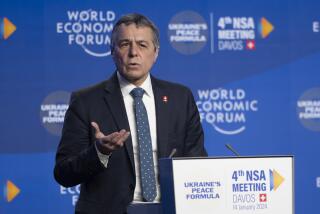Catholic-Muslim strife still echoes in this marble forest
Mansur Escudero knew the answer before he asked.
Approaching the guard at Cordoba’s majestic once-a-mosque, now-a-cathedral, Escudero posed the question: May I say Muslim prayers inside?
The slightly startled Spanish guard gave an emphatic no. This is a Catholic church, he said, and as such it is absolutely prohibited to pray in any other faith. Escudero persisted, but the guard was firm.
This is a cathedral, the guard repeated, growing more agitated: “A CA-THO-LIC CHURCH.”
The 1,200-year-old architectural wonder that is one of Spain’s most renowned landmarks is at the center of a turf war over religious space, cultural recognition and rivalries that are both ancient and contemporary.
Known as La Mezquita in Spanish and the Great Mosque in English, its spectacular forest of striped arches and jasper-and-marble columns constitutes one of ancient Islam’s most iconic legacies. But La Mezquita has served as a consecrated Catholic church for nearly 800 years -- ever since Spain’s Catholic monarchs ejected Islamic forces that had ruled most of the Iberian Peninsula for more than five centuries.
The scuffle over La Mezquita is echoed throughout Spain these days as members of each faith tests the other’s tolerance in this overwhelmingly Roman Catholic country with a fast-growing Muslim minority. Tensions were further inflamed when Islamic militants blew up commuter trains in Madrid three years ago, killing nearly 200 people.
The dispute has special resonance in Cordoba, an Andalusian crossroads that beginning more than a millennium ago was the capital of Moorish Spain and one of the Western world’s greatest centers of intellectual and artistic culture.
Some of today’s Muslims may long for Islam’s glorious past, but Mansur Escudero insists he just wants a place to pray.
“We could be an example for the world,” he said, “awakening the consciences of both Christians and Muslims and showing it’s possible to put aside past conflicts.”
Inspired by the pope
Escudero, a Spaniard who converted to Islam 28 years ago, has been fighting to gain prayer rights here for much of his life. He decided to try again, inspired by the journey to Istanbul last fall of Pope Benedict XVI, who stood alongside an imam in that Turkish city’s famous Blue Mosque, faced Mecca and prayed.
Escudero and the Islamic Council of Spain that he heads took the case straight to the Vatican, writing the pope to suggest that the site in Cordoba become a “singular and unique ecumenical space” in which both Christians and Muslims could pray.
The pope did not write back.
However, the bishop of Cordoba, Juan Jose Asenjo, was more than happy to respond. Far from fostering peace, he said, the sharing of places of worship would only “generate confusion” among the faithful.
The stone compound that embraces the cathedral, with courtyards and fragrant orange trees, abuts Cordoba’s old Jewish Quarter, testament to a community that flourished and lived in relative peace under the Muslim caliphate. A few narrow, winding streets away is one of only three medieval synagogues that have survived in Spain.
Muslims are not allowed to pray inside the Great Mosque, with its ornate, golden mihrab, or prayer niche, that points to Mecca. But Catholics can attend Mass every day. On a recent Sunday, soon after Escudero made his quixotic pitch to the guard, Cordoba’s clerics donned purple robes and led a morning service for about 50 parishioners.
There is something a bit incongruous about a Catholic Mass inside what still looks like a mosque: a life-size crucifix hangs under a horseshoe-shaped Moorish arch; arches also frame the priests’ red velvet chairs.
Christian elements were added as a church was in effect erected inside the mosque during the 16th to 18th centuries, including giant mahogany choir stalls and altars, numerous gated chapels along the walls, Gothic crosses and a baroque bishop’s throne.
On this particular Sunday, perfumed smoke floated from silver censers toward the cathedral’s vaulted ceilings while parishioners recited the Lord’s Prayer and took Communion.
In an interview afterward, Father Manuel Perez Moya said that because the building was consecrated as a cathedral, it is impossible to permit Muslim worship of any kind. Had it not been converted to a church, he added, the Great Mosque might have suffered the fate of other conquered property and been destroyed.
“It is thanks to this being a living cathedral that such a beautiful reality could be protected,” he said.
Church leaders also note that, in a reflection of the centuries’ cultural layering, a Visigoth basilica stood on the site before the mosque was built.
What really worries many priests, however, is the specter of Spain’s Muslims wanting more than an occasional prayer.
“The problem is you let them pray, and then maybe they will try to take territory,” Perez Moya said.
Escudero, who was christened Francisco and schooled by Jesuits before his conversion, says such fears are absurd.
“I think they are afraid of seeing many Muslims praying while their churches are empty,” he said.
A slight, compact man with a trim gray beard, Escudero is a psychiatrist and the father of 10 children by two wives. His first wife was killed nine years ago by an intruder who broke into the family home. It happened as she was developing a website for Muslims in Spain, which Escudero says is wildly successful today. He suspects her activities might have had something to do with her death. (Escudero was “married” to both wives at the same time, although Spanish law did not recognize the second union.)
Views among Catholics
Spanish Catholics are of mixed minds about whether Muslims should be allowed to pray at La Mezquita.
“Sure, let them -- the day I can pray in a mosque,” Luis Recio Mateo, 61, a self-described historian and tour guide dressed in a dapper gray suit, said as he left Mass. “If I go into a mosque in Morocco or Mauritania or Constantinople, they’ll tell me I’m an infidel. Nor should Muslims pray in my cathedral.”
But Marta Perez, a 19-year-old math student visiting from Valencia, said she had no objections. “Historically and culturally, it belongs to them,” she said.
Ofemia Casado, 39, took the long view. “Before the Catholics and before the Muslims, it was the Romans, the Visigoths, the Phoenicians, the Barbarians.... Are we going to let them all come back?” she mused. “It belongs to no one and to everyone.” Best just to let it be, she concluded, rather than peel back the layers of an onion.
Splintered community
Depending on who’s counting, at least 1 million Muslims live in Spain (a country of 40 million people), and only about 1,000 Muslims live in Cordoba, a city of 320,000. In Spain’s splintered Muslim community, Escudero is considered a moderate, at odds with more radical factions making inroads in some parts of the country.
In numerous cities, local Catholic groups have protested and in some cases blocked plans to build mosques or expand Islamic cultural centers.
Escudero says that over the years, authorities in Cordoba occasionally allowed a visiting Muslim dignitary to pray in the Great Mosque -- including Saddam Hussein in 1974. But in the last decade or so, church officials have been increasingly against the idea, he said, perhaps in reaction to the expanding Muslim presence in Spain.
Whereas Escudero thinks of the pope’s appearance in the Blue Mosque, it’s another Istanbul landmark that priests here might cite: the Hagia Sophia, a 6th century Byzantine church that was converted to a mosque by the Muslim Ottomans in the 15th century. In theory, it is today a museum and no one is allowed to pray there, although Muslims occasionally do.
When Escudero learned of the Cordoba bishop’s rejection of his latest plea, he protested. On a gray morning, he stood outside the Great Mosque’s Door of Pardon, spread a small carpet on the sidewalk, knelt and prostrated himself in prayer.
News photographers snapped many pictures. And police held a tiny group of yelling protesters at bay.
*
More to Read
Start your day right
Sign up for Essential California for news, features and recommendations from the L.A. Times and beyond in your inbox six days a week.
You may occasionally receive promotional content from the Los Angeles Times.







